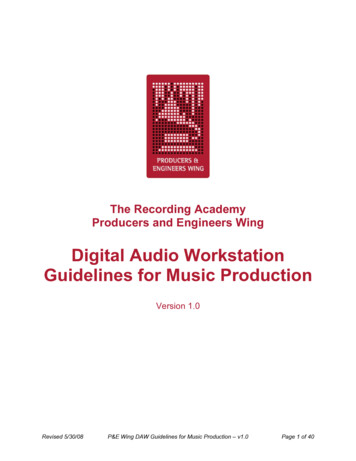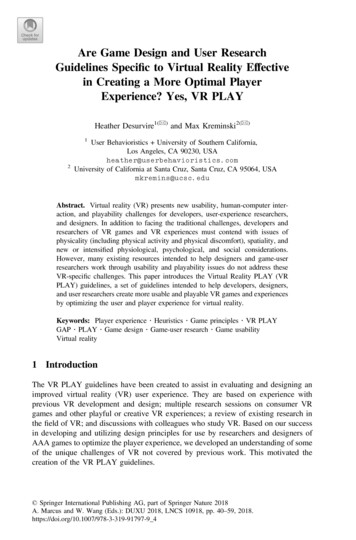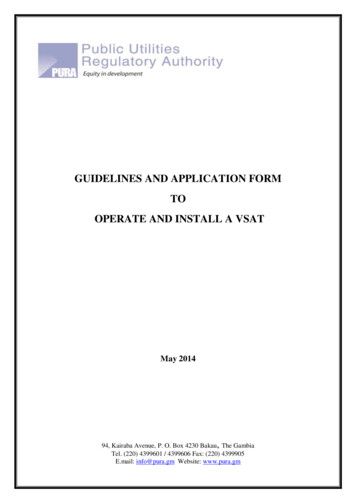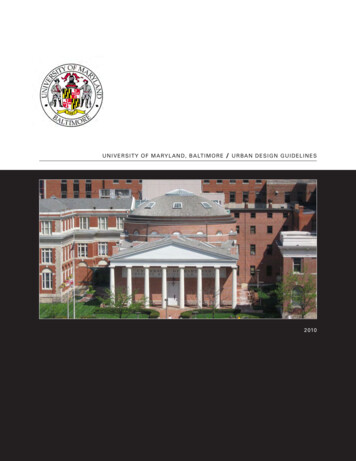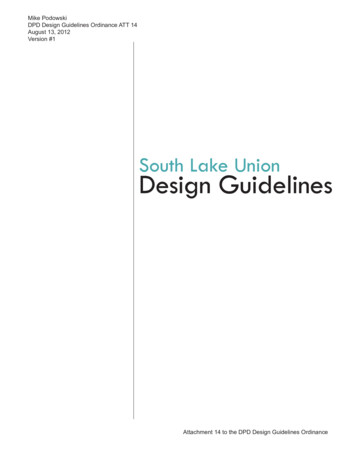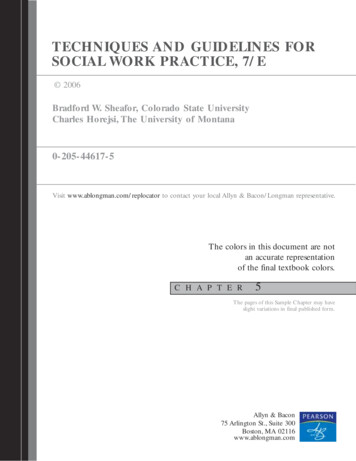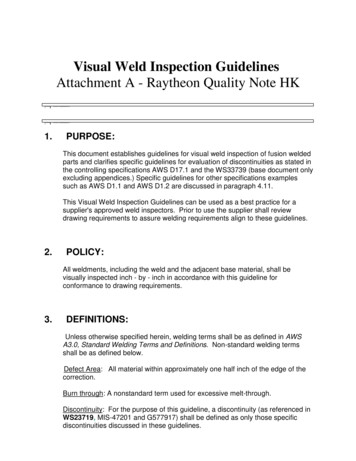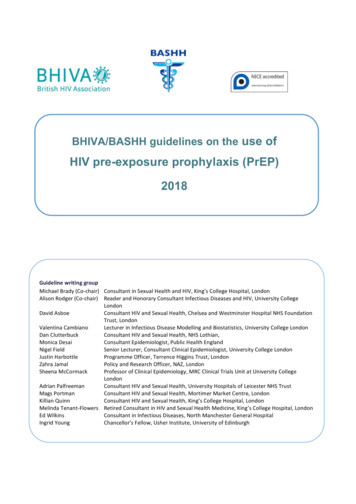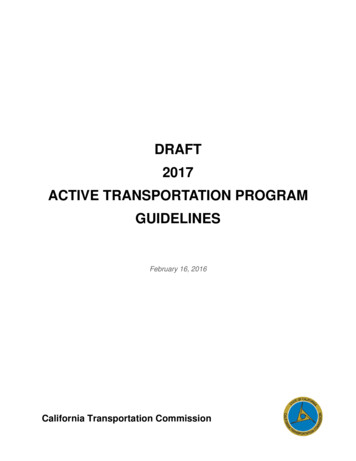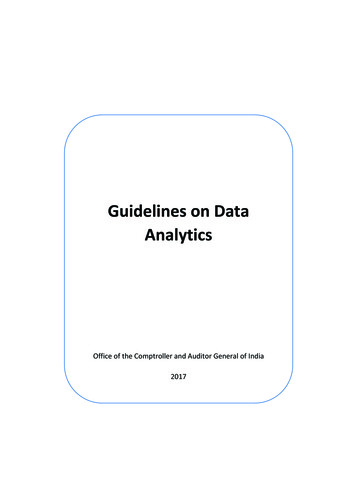
Transcription
Guidelines on Data Analytics Office of the Comptroller and Auditor General of India 2017
Preface Technology plays a significant role in modern day governance for enhancing delivery of public goods and services. The diverse technology systems are continuously producing volumes of data in disparate forms, throwing up immense opportunities for data analytics. As a responsive Supreme Audit Institution, we have to be institutionally agile to keep pace with such developments and embrace the evolving opportunities in data analytics. The Big Data Management Policy, formulated in 2015, envisioned the broad contours of the data analytic framework for the Department. Creation of the Centre for Data Management and Analytics was the first step in establishing this framework. The Guidelines for Data Analytics is a major initiative in institutionalising the practice and use of data analytics in the Department. These guidelines explain the concept of data analytics, outline the data analytic process and envisage development of data analytic models. Data analytics is an evolving discipline and therefore these guidelines would have to be periodically reviewed and updated. I am sure that officers and staff of the Department would find these guidelines useful and would apply them purposefully towards enhancing the quality of public accounting and auditing. Shashi Kant Sharma Comptroller and Auditor General of India September 2017
1. Data Analytics Introduction 1.1Data analytics is the application of data science1 approaches to gain insights from data. It involves a sequence of steps starting from collection of data, preparing the data and then applying various data analytic techniques to obtain relevant insights. The insights include, but are not limited to, trends, patterns, deviations, inconsistencies, and relationships among data elements identified through analysis, modelling or visualization, which can be used while planning and conducting audits. Data analytics adds a competitive advantage to enable information based decision making. As it is an evolving discipline, the possible utilities of data analytics are still under experimentation and exploration in both public and private sector. 1.2These guidelines prescribe the methodology of employing data analytics in the auditing function of Indian Audit and Accounts Department (IA&AD). The data analytic principles and methods will, however, be applicable to the domains of accounting and administration. 1.3These guidelines have been developed as a follow up of the Big Data Management Policy issued in September 2015 and subsequent initiatives in use of data analytics in IA&AD, particularly in audit. The guidelines draw on the existing guidelines on Performance Auditing, Compliance Auditing, Financial Auditing, 1 Data Science refers to an emerging area of work concerned with the collection, preparation, analysis, visualization, management, and preservation of large collections of information. Although the name Data Science seems to connect most strongly with areas such as databases and computer science, many different kinds of skills Ͳ including nonͲmathematical skills Ͳ are needed Ͳ An Introduction to Data Science Ͳ Jeffrey Stanton, Syracuse University.
Auditing Standards and other relevant instructions and manuals in IA&AD. Scope for individual initiative and professional judgment 1.4While these guidelines are prescriptive in nature, these are not intended to supersede the professional judgment of the Accountant General2. The Accountant General is expected to make situation or subject specific adjustments to the provisions set out in these guidelines. However, Accountants General will be expected to document the rationale of all significant departures from the guidelines and obtain authorization from the competent authority. Data analytics and IA&AD 1.5The IA&AD has a very broad audit mandate, which includes audit of Union Government and State Governments and extends to bodies or authorities such as statutory corporations, government companies, autonomous bodies constituted as societies, trust or not for profit companies, urban and local bodies and to any other body or authority whose audit may be entrusted to the Comptroller and Auditor General of India. Audits are conducted with reference to such accounts, vouchers and records as may be received in the audit office and/ or in the accounts office and may include online data, information and documents of the auditable entity. The Auditing Standards envisage obtaining sufficient and appropriate evidence to support the auditor’s judgment as well as conclusions regarding the organisation, programme, activity or function under audit. This would involve study and analysis of data collected before and during the audits. With limited available resources, Audit undertakes a risk based audit approach and applies analytical 2 The term Accountant General includes all heads of Departments (HoD) of the rank of Senior Administrative Grade and above, within the IA&AD.
procedures, test of controls and substantive checks on available and selected data during planning and execution of the audits. With rapid computerisation, most of the activities of auditable entities are being recorded electronically, in various IT systems. These electronic records or ‘data’, if interpreted properly, can provide insights into past events, guide corrective action in the present and forecast future events thereby enhancing the efficiency of the auditor. 1.6Data is available to audit today, in different forms and from different sources. Data analytics provides the potential to analyse these data sets and obtain insights to assist in the audit processes by identifying patterns, trends, descriptions, exceptions, inconsistencies and relationships in data sets and their variables. The insights so drawn would assist in setting the direction of the audits, by primarily identifying areas of interest or risk and in identifying exceptions. Data analytics in Audit 1.7 Data analytics begins with identification and collection of various data sources for a particular audit. The analysis of data through various data analytic techniques will yield insights on the working of the audited entity. The risk areas or areas of interest identified through such an exercise will assist in identifying audit objectives and developing an Audit Design Matrix. Data Analytics will also assist in identifying the sample of audit units where substantive checks will be conducted. 1.8The various analyses can then be built into a reͲexecutable Data Analytic Model. This will ensure that results of data analysis can be used repetitively with periodic updating of data. Establishing a mechanism for receiving data periodically will be crucial for such an approach. The scope of the model once built can be expanded by
incorporating the feedback from substantive checks and bringing in additional data sources. Thus, data analytics in IA&AD is not envisaged to be a oneͲoff process for a specific audit, but is expected to evolve over time. 1.9The schematic diagram of the process is provided below: Feedback Figure 1Ͳ Data analytic process The data analytic process has been explained in detail in subsequent chapters. 1.10 The Centre for Data Management and Analytics (CDMA) will be the nodal body for steering data analytic activities in IA&AD. CDMA will provide guidance to the field offices on data analytics and pioneer research and development in the future direction of data analytics.
In the structure envisaged for data analytics in IA&AD, data analytics is to be conducted by each field office as per its annual plan. The data analytic activities in a field office will therefore be the responsibility of the Head of Department (HoD), who will constitute a Data Analytic Group. The Data Analytic Groups constituted in the field offices under the charge of a Group Officer will be responsible for steering data analytics in the field offices. To obtain meaningful insights for audit from data analytics, knowledge in the area of audit will be essential. The exercise of data analytics is therefore envisaged as a collaborative effort with technical knowledge of the Data Analytic Groups and domain expertise from functional groups in the field office, complementing each other. An indicative role assignment for data analytic activities is provided at Annexure 1. Hiring of external experts 1.11In specialised areas, field offices could consider engagement of external experts, if such need is justified. Engagement of external experts should, however, be as per the guidelines issued by IA&AD from time to time. Some of the specialized areas for such hiring could be related to data handling, applying advanced data analytic techniques or management of data repository.
2.Data Acquisition and Preparation 2.1 Data analytic process encompasses data acquisition, data preparation, data analysis, results and analytic models. This chapter addresses identification and collection of data as well as handling of collected data and preparing it for analysis. It is however, important to understand the data types and their sources before initiating the process of acquisition, preparation and analysis. Understanding data types 2.2 The core of data analytics is ‘data’. Data can be measured, collected, analysed and visualized to give a meaningful interpretation of facts and reasons. Data can be understood and categorised as follows: Figure 2Ͳ Types of data x Unstructured or structured data: Unstructured data comprises data such as text, image, audio or video data, which cannot be readily ‘tabulated’ for statistical or mathematical analysis. Structured data on the other hand refers to data in tabular form. Structured data could be categorical or numerical.
xCategorical or numerical data: Categorical data could be nominal (data not amenable to ordering e.g., name, gender of a person) or ordinal (data amenable to ordering e.g., ranking based on quality of service: highly satisfied; satisfied; not satisfied). Examples of numerical data could be interval data (e.g. temperature which is amenable to identifying differences in values) or ratio data (e.g. expenditure of a company which can be compared as multiples of one another). Operation Nominal Ordinal Interval Ratio 9999 Count 999 Ordering of values 9999 Mode 999 Median 99 Mean 99 Addition/Subtraction 9 Multiplication/Division 9 Whether true zero exists Figure 3Ͳ Possible operations with types of data x Number of variables – Univariate, bivariate or multivariate data: Based on the number of variables in a data set, it may be called univariate, bivariate or multi variate data. Univariate data has only one variable. It is essentially descriptive in nature. Analysis of univariate data involves summarization and identification of patterns in the data. Bivariate data has two variables and statistical analysis can be applied to understand the relationship between two variables. They can be represented on XͲY axis and visual representation through plots like scatter plot will be useful in understanding relationship patterns in this type of data. Multivariate data involves multiple variables. Statistical analysis would be required to analyse the data and to discover relationships and dependencies between the variables. Visual representation is a useful tool in
understanding the relationship patterns among different variables, and the plots can be drawn on three dimensions, X, Y and Z. Plots can thus include more than three variables using appropriate visualization approaches. Sources of data 2.3Identification of various sources of data available to the IA&AD is the corner stone of the data management framework. The Big Data Management Policy categorises various data sources as: Internal data sources: This comprises xxxxx Combined Finance and Revenue Accounts VLC data base GPF and Pension data in A&E offices Data generated through Audit process Any other data available in the department External data sources: This comprises a) Audited entities’ data available with the department in its professional capacity which includes x Financial and nonͲfinancial data of audited entities x Programme specific data including beneficiary databases x Other data pertaining to audited entities b) Third party data which comprises data available in the public domain and includes: x Data published by Government and statutory authorities like o Census data o NSSO data o Data published by the various Ministries/Departments o Data available in data.gov.in
x2.4o Reports of various commissions o Other Reports and data pertaining to Union Government /States Other data available in public domain o Surveys and information published by NGOs o Industry specific information published by CII, FICCI/NASSCOM etc. o Sector specific information published by various organizations o Social media etc. Field offices may encounter situations where the required data is available in manual form. The field offices should then decide whether the manual data can be converted into electronic form by creating electronic data sets. For instance the details contained in sanction orders received in audit offices may be converted into an electronic data file, which can be utilised for data analytics. Data Identification 2.5 As a part of collecting and maintaining a comprehensive data base on auditable entities, field offices should formulate a mechanism for identifying availability of electronic data with audited entities/third party data within their jurisdiction and updating them periodically. Data acquisition 2.6Data acquisition involves obtaining access to and collecting data keeping in view the ownership, security and reliability of data collected. Data access 2.7Since IA&AD is not the owner of several data sources required for data analytics, data availability would remain a challenge in the
medium term. Exacerbating this problem is the reluctance by many of the audited entities to part with their data. Continuous persuasion and monitoring with the audited entities taking support from relevant provisions of the CAG’s Duties, Powers and Conditions of Service, Act 1971 and Regulations on Audit and Accounts 2007 will be the way to address this issue. 2.8Data may be provided to the auditors on the entity’s sites through access to the system. This can be a readͲonly access without any transaction rights so that the system’s performance is not affected. The data may be provided through backup files created in the entity’s environment and shared on a removable media with the auditors. The data may also be shared electronically using electronic transfers though networks Ͳ LAN or WAN or internet or a VPN, as the case may be. 2.9Indicated below is a progression in the way auditors can access data from their audited entities, starting from manual records to online, real time data sharing. However, it is not essential that the progression be sequential and auditors accessing only manual records may start accessing real time data electronically without going through the intermediate steps. The access to data solely depends on the capability of the auditors, the auditing environment and the level of access established between the two.
Figure 4Ͳ Access to data 2.10One of the ways to deal with data access is through involvement of audit from the design stage of the IT systems when it may be possible to incorporate the data requirements of audit into the system design. This would facilitate acquisition of data in the requisite format. To ensure this, field offices would need to convey the data requirements for audit to the concerned entities at the stage of important system developments thereby facilitating access to requisite data when the system is operational. These data requirements could cover information sets to be acquired, format of data, mode of transfer and periodicity of data to be made available to audit. At the same time, access to the complete system or complete data, if required for any specific audit, such as performance audits, systems audits, IT audits, special audits etc., should not be precluded by involvement of auditors at the system development stage. Data handling at different levels of data access modes 2.11When the data is shared in removable media, the auditors need to have hardware compatible to run the media Ͳ CD, DVD, tape drive or an USB drive etc. Along with the capacity to run the media, the auditors need to have appropriate operating system and database
application (like the RDBMS) where the data can be read from the media. Thus, an environment similar to the source from which data is received is to be created to be able to read the data. Read only rights are typically the view rights granted to the auditors at the entity’s systems which should facilitate viewing/copying of the requisite data. In electronic transfer of data, the data in file form is transferred using networks such as through mail, file transfer protocols etc. In online access, data is made available through cloud from a remote server. Real time systems provide access to live systems and the information contained therein in a real time mode. Real time data access provides the possibility of real time processing, thereby enabling the development of continuous auditing approaches through embedded audit modules3. All field offices should endeavour to evolve an appropriate data access mechanism with the data source organisations so as to access data on a periodic/real time basis into their data repository/ data analytic models. Collection of data 2.12Data collection is the systematic approach of gathering and measuring information from a variety of sources to get a complete and accurate picture of an area of interest. The IT system should be studied and understood while collecting data, which would facilitate identification and requisition of relevant data. These can be complete databases, selected tables out of the databases, selected data fields of tables in the databases or data pertaining to specific criteria/ condition for a particular period, location, class etc. Depending on the data size, this may be obtained in flat file or 3 Embedded Audit ModuleͲ Audit module embedded/ integrated with the IT systems, thus receiving online data including real time data.
dump file formats. Where it is not possible to obtain the relevant data/tables for analysis the entire data may be collected. 2.13While collecting data, the authenticity, integrity, relevance, usability and security of the data sets should be ensured4. For ensuring the integrity of data (i.e. – that some data is not lost), checks such as counting the total number of records or sum of numeric columns adding up to total (hash totals) may be undertaken. For ensuring that data is complete, completeness control measures should be undertaken, e.g., taxes collected by individual taxpayers should add up to the total tax collected in the Tax office. The auditor should obtain a certificate stating that the data is complete and the same as in the IT system of the audited entity at the time of receiving data. An indicative template of such certificate is provided at Annexure 2. It should be ensured that only authorized personnel handle data transfers from the data sources to the auditors. The access to such data should be through appropriate access controls to prevent any unauthorized access to data. Data from an entity not within audit jurisdiction 2.14Field offices may require data sets whose ownership is not with auditable entities under their audit jurisdiction. The field office may then seek the assistance of the concerned field office which has audit jurisdiction over such auditable entities and the concerned field office should provide all assistance in obtaining the required data sets. 4 Big Data Management Policy, Section IVͲ2. Data Management protocols have to ensure that data satisfies the following characteristics: Authenticity Ͳ Data is created through the process it claims. Integrity Ͳ Data is complete, accurate and trustworthy. Relevance Ͳ Data is appropriate and relevant for the identified purpose. Usability Ͳ Data is readily accessible in a convenient manner. Security Ͳ Data is secure and accessible only to authorised parties.
Ownership of data 2.15The ownership of the data sets remains that of the audited entity/ third party data sources and IA&AD holds this data only in a fiduciary capacity. Once the data sets are obtained from the data sources, the HoDs should assume the ownership of the data sets and should exercise such controls on security and confidentiality of the data as envisaged for the data owner in the audited entity. The concerns and instructions of the owners of data, if any, should be ascertained and kept in mind. The data provided by data sources must be kept in safe custody for reference and all analysis must be undertaken only in copies of the source data. Compliance to all rules, procedures and agreements regarding data security, confidentiality and use of data of the audited entity/ third party must be ensured by audit within the overall framework of data protection and security prescribed by IA&AD from time to time Data security 2.16In case of electronic records, making multiple copies, modifying data, deleting etc. are easier and faster when compared to manual records. Data security protocols applicable to the audited entity may be followed by the auditors for handling acquired data sets. The data analytics results, however, may be dealt with in the manner prescribed by IA&AD. 2.17While handling data, the basic approach should be to limit, to the bare necessity, the number of personnel with access to the raw data and to establish a trail of personnel who have accessed data. Complete and chronological record of all data shared between data source owner and the auditor should be stored in an unaltered and secure manner. It should be ensured that computers which are used for data analytics are not connected to internet.
2.18Given the sensitivity of the data obtained from the audited entity, it should be handled with due diligence to avoid any kind of unauthorised disclosure from auditors. Information Security measures of government5, those specified in Information Systems Security Handbook of IA&AD, along with any specific agreement between the auditor and the data source owner should be followed to ensure confidentiality and security of data. Data reliability 2.19Data is said to be reliable when the data accurately captures the parameter it is representing. Data reliability is a function of authenticity, integrity, relevance and usability of data. Data reliability can be affected because of the methods of generation /capture of data. As IA&AD has to rely on data generated from other sources, it is important that reliability of each data source is understood a priori so that adequate caution can be exercised in its utilisation. 2.20Generally auditors would have limited means to ensure reliability of data while receiving data from the auditable entity as reliability can be assessed only after using the data in audit process, when analysis could reveal internal inconsistencies or incompleteness. However, auditors need to be vigilant about data reliability and exercise due precaution while obtaining data from auditable entities. Generally, if the manual and IT system are operating in parallel, the chances of errors in data are higher. Similarly an MIS system involving manual data entry is likely to be less reliable than systems where MIS data is directly generated through an IT system. Information System audit of the IT system, if any conducted earlier, can provide insights on data reliability. 5 Guidelines for use of IT Devices on Government Network dated 14 October 2014, %20Network%20 0.pdf
2.21Auditors need to clearly differentiate between the purposes for which the data set would be put to use while considering data reliability. Consideration of data reliability would be significantly higher for data sets planned for usage as audit evidence to support audit conclusions as compared to data sets planned for drawing broad insights while planning. The Big Data Management Policy mentions various third party data sources which can be used for audit in IA&AD. While third party data can strengthen the audit planning process, the auditor should use professional judgment while using such data sources as audit evidence and should ensure that it meets the criteria laid down as per auditing standards of CAG of India. For example, Survey Data of an academic institution related to sanitation can be used to identify issues in the sector and may feed into the sampling process (identifying high risk /low risk administrative units), along with other parameters in the audit planning stage. However, whether the analytic results of the survey data can be used as audit evidence depends on whether it satisfies the conditions, criteria and standards of audit evidence laid down for IA&AD. Data preparation 2.22The identified datasets, as available, may not always be in the desired form, size or quality for analysis. Hence the data would have to be prepared from the available format to the desired format. Understanding the data is a prerequisite for the auditor to decide on the ‘desired format’ of data for subsequent analysis. 2.23Data preparation is the process of organizing data for analytic purposes. It involves various activities such as restoration, importing of data, selection of database/ table/ record /field, joining datasets, appending datasets, cleansing, aggregation and treatment of missing values, invalid values, outliers and
transformation. These activities may either be interconnected or be a series of independent steps. Data preparation is a project6 specific phase. Though the broad steps may not vary significantly, the order of the subͲprocesses or tasks involved may vary according to the project. Further, there may be a need to back track or repeat certain steps/tasks. Data restoration 2.24The data from the data source should be copied and restored in the auditor’s computer for further analysis. While using data in dump/ backup format, it will be necessary to bring the data tables to its original format through a data restoration process. Before restoring a database backup/dump file, some basic information such as database software version, operating system, database size is required. Based on this information, an environment should be created to restore the backup/dump file, if not already present. Database restoration requires adequate technical knowledge of the database, as steps that need to be followed while restoring a database may vary according to the database software. While it may be possible to restore a lower version backup /dump file in a higher version of database software, it could involve compatibility issues, which should be confirmed from the Database Administrator. Identification of tables/fields of interest 2.25In order to optimize computational speed and capacity, it is essential that only the relevant data variables are kept for analytical purposes. Identification of the relevant field/table/variable of interest would have to be carried out with utmost care as all the 6
1. Data Analytics Introduction 1.1 Data analytics is the application of data science1 approaches to gain insights from data. It involves a sequence of steps starting from collection of data, preparing the data and then applying various data analytic techniques to obtain relevant insights. The in


